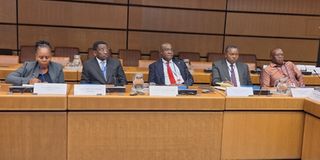Premium
Kenya’s 2032 nuclear power plans gain momentum

From left: Kilifi Deputy Governor Flora Chibule, Siaya Governor James Orengo, NuPEA CEO Justus Wabuyabo, Secretary Renewable Energy Eng. Isaac Kiva and Kilifi North MP Owen Baya during a week-long engagement of policy and decision makers in Vienna, Austria.
IN Vienna, Austria
Kenya’s quest to venture into nuclear power energy has begun gathering momentum amidst some fears and resistance from a section of Kenyans, with the backing of some environmental activists.
According to the Secretary for Renewable Energy, Engineer Isaac Kiva, the country is working around the clock to ensure it begins Nuclear power production by 2032.
“In our projections for the next twenty years, we view that nuclear is going to play a key role," says Mr Kiva.
The government has allayed fears of a slow pace, maintaining everything is still on course to ensure the rising demands are addressed, with more demand drivers expected to come on board with the establishment of special economic zones. “2032 is still viable because we still have other resources which we are already developing.”
A section of policy and decision makers have visited Vienna, Austria, for a week-long technical visit on National capacity building for Kenya’s Nuclear Power program at the International Atomic Energy Agency.
The delegation is drawn from National and three County governments of interest for the nuclear power project as well as from National Assembly’s Energy Committee, Senate, the Regulator, the generator-KENGEN and the Nuclear Power Energy Agency-NuPEA.
The move signals the country’s quest to begin development of its first nuclear power plant in the coastal region, preferably in Kilifi County, in line with Vision 2030.
The proposed project targets the generation of a total of 1,000 MegaWatts of electricity, with development of the plant anticipated to kick off in 2027 and begin operations by 2032.
The technical visit organised by NuPEA in partnership with the International Atomic Energy Agency -IAEA saw the delegation visit Laboratories in Vienna, focusing on peaceful applications of nuclear science and technology, and an operating nuclear power plant in Paks, Hungary.
According to NuPEA Chief Executive Officer Justus Wabuyabo, the visit is integral to Kenya’s nuclear program, providing critical insights into nuclear power plant establishment and operation by raising awareness among key decision-makers and policymakers.
This is with respect to commitments and infrastructure required for a nuclear power program, as well as associated risks and benefits of the program, and the need for attainment of a National position.
“If Kenya wants to implement its nuclear program, we must be ready to invest time and resources. This conversation must be heard with held with all Kenyans because it’s a project that has implications for everyone”, says Mr Wabuyabo.
Establishment of Nuclear Power is part of Kenya’s Vision 2030 that was formulated by the Grand Coalition Government under the leadership of late President Mwai Kibaki and former Prime Minister Raila Odinga.
Siaya Governor James Orengo, who was a member of that Cabinet, says there’s very little progress.
“I think there’s a trust deficit and a crisis of confidence because of the history of the use of nuclear power,” says Mr Orengo.
A National position, experts say, is key for the successful implementation of the nuclear power program, and the policy and decision makers play a major role in achieving and sustaining a National position.
Already, the community in Kilifi County has expressed its resistance to the project, leading protests in mid 2024 and stopping the erection of a meteorological mast at Uyombo Girls Secondary School which was to be used to collect Data that would inform the suitability or non-suitability of constructing the power plant in the area, hence derailing the feasibility study.
A Kenyan delegation is led by Engineer Isaac Kiva, Secretary for Renewable Energy.
Also present is Kilifi Deputy Governor Flora Chibule, Senator Justice (Rtd) Stewart Madzayo, Kilifi North MP Owen Baya, County MP Getrude Mbeyu and Mastangoni Ward MCA Hassan Mohamed.
National Assembly energy committee members present are Cecilia Ngitit(Turkana County MP), George Aladwa(Makadara), Julius Mawathe (Embakasi South and Victor Koech Mandazi(Chepalungu).
The Nuclear Power and Energy Agency-NuPEA has identified two possible regions in the coast region, with priority being Kilifi County, then Kwale. The third zone with a possibility of hosting the project is Lake Victoria, in Siaya County.
Kwale County, which is the second best option, has its CEC member in charge of Lands, Environment and Natural Resources, Saumu Beja, attending, while Siaya Governor James Orengo, since preliminary reports have identified the region as better placed in the Lake Victoria Belt.
Lake Turkana is also a possible location and is listed fourth in terms of suitable sites.
Currently, there are 417 nuclear power reactors in 31 countries with a combined Capacity of 377 GigaWatts. As of April 2025, there were 61 nuclear reactors under construction in 15 countries with an anticipated generation capacity of 64GW.
In Africa, nuclear power reactors share is 0.9 percent as of 2023, with only South Africa, which has two operational reactors that produce 1854 Megawatts. Egypt is currently constructing four reactor plants, which will yield 4400 MegaWatts once complete.
Kenya is angling to become the third country in Africa to operate a nuclear power plant.


